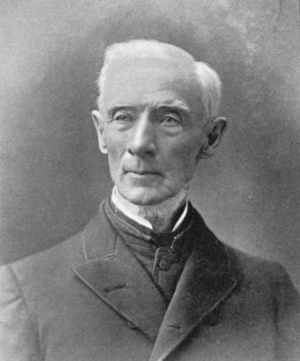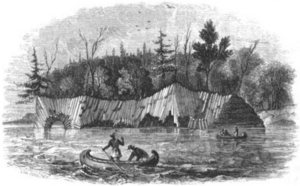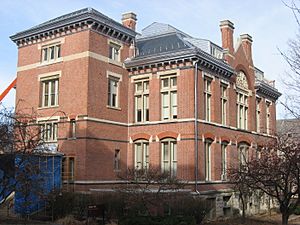Richard Dale Owen facts for kids
Quick facts for kids
Richard Dale Owen
|
|
|---|---|
 |
|
| Born | January 6, 1810 Lanarkshire, Scotland
|
| Died | March 25, 1890 (aged 80) New Harmony, Indiana, U.S.
|
| Cause of death | Accidental poisoning |
| Resting place | Maple Hill Cemetery (New Harmony, Indiana) |
| Monuments | Colonel Richard Owen (bust) at the Indiana Statehouse, Indianapolis |
| Occupation | U.S. military officer, geologist, and educator |
| Employer | Indiana University; Purdue University |
| Spouse(s) |
|
| Children | 2 |
| Parent(s) |
|
| Relatives |
|
| 1st President of Purdue University | |
| In office August 13, 1872 – March 1, 1874 |
|
| Preceded by | Office Created |
| Succeeded by | Abram C. Shortridge |
Richard Dale Owen (born January 6, 1810 – died March 25, 1890) was a Scottish-born scientist, teacher, and military officer. He moved to the United States in 1828 and settled in New Harmony, Indiana.
Owen was trained as a scientist and doctor. He served as an officer in the U.S. Army during the Mexican–American War and the American Civil War. After the Civil War, he taught at Indiana University for fifteen years. He also became the first president of Purdue University from 1872 to 1874.
Richard Owen helped his brother, David Dale Owen, with early studies of the Earth's geology in the Northwest Territory. In 1860, Richard became Indiana's second state geologist. He studied geology, weather, Earth's magnetism, and earthquakes. He also wrote scientific books about geological surveys in several U.S. states.
During the American Civil War, Owen was a colonel in the Union army. He commanded Camp Morton, a prison camp for 4,000 Confederate soldiers in Indianapolis. He was known for treating the prisoners kindly. A bronze statue was placed at the Indiana Statehouse in 1913 to honor his leadership at Camp Morton. Buildings at Indiana University and Purdue University are named after him.
Contents
Early Life and Education
Richard Dale Owen was born on January 6, 1810, in Lanarkshire, Scotland. His father, Robert Owen, was a famous social reformer and textile maker. Richard's mother, Ann Caroline Dale, was the daughter of a wealthy textile manufacturer. Richard was the youngest of seven children who lived to adulthood.
Owen grew up at his family's home in Scotland. He was taught by private tutors and went to grammar schools in New Lanark. He also studied chemistry, physics, and natural sciences at a school in Switzerland. This school taught him new ways of learning. After returning to Scotland, Owen continued to study chemistry.
In 1828, Owen moved to the United States. He joined his brothers in Indiana, where their father had started a special community called New Harmony. Even though the community experiment ended, New Harmony remained Owen's home for most of his life. He often returned there to do research and write.
Family Life
In 1828, Owen had a short marriage to Martha Chase, a teacher in New Harmony. She passed away soon after they married.
On March 23, 1837, Owen married Anne Eliza Neef in New Harmony. It was a special day because his two brothers also married Anne's sister and another woman in the same ceremony. For a few years, the three married couples lived together in the Owen family home. Later, they each started their own households.
Richard and Anne Owen had two sons, Eugene Fellenberg Owen and Horace Pestalozzi Owen. Both sons became officers in the Union Army during the American Civil War, just like their father. Eugene later became a farmer, and Horace became a businessman and banker in Indiana.
Career Highlights
Richard Owen was very interested in education and social change, like his father and older brother. But he mainly focused on science. He had a long career as a university professor and a geologist. He also served as a military officer in two wars.
Becoming a Scientist

In 1848, Owen started helping his brother, David Dale Owen, who was Indiana's first state geologist. They worked on geological studies in the Northwest Territory. In 1849, Owen helped survey northern Minnesota and the shores of Lake Superior. He recorded air pressure and drew pictures of what they saw.
Later that year, Owen became a professor of natural science at the Western Military Institute in Kentucky. He taught there until 1859. During this time, he wrote an important book called Key to the Geology of the Globe (1857). He also earned a medical degree in 1858. Owen left the Institute in 1858 because he was against slavery.
After returning to Indiana, Owen became an assistant state geologist. When his brother David passed away in 1860, Richard Owen became Indiana's second state geologist. He also finished and published David Owen's geological survey of Indiana. Because of this role, Owen also became a faculty member at Indiana University.
Serving in the Civil War
When the American Civil War began in 1861, Owen joined the Union Army. He served as a lieutenant colonel and fought in several battles. He was promoted to colonel and stayed in the army until December 1863.
In February 1862, Colonel Owen was put in charge of Camp Morton in Indianapolis. This camp held 4,000 Confederate prisoners of war. Owen set up daily routines and rules for the camp. He was known for treating the prisoners humanely. He gave them books and let them form clubs for singing, acting, and sports. He even created a bakery staffed by the prisoners, which saved money and provided more food.
Owen was also a strict officer. He made sure rules about mail and visitors were followed. Many prisoners were thankful for his kindness. Other officers respected him for how well he organized and managed the camp.
In May 1862, Owen and his regiment were sent to active duty in Kentucky. Some prisoners at Camp Morton even asked the governor to keep Owen there, but their request was denied. In September 1862, Owen was captured at the Battle of Munfordville. The Confederate General, Simon Bolivar Buckner, personally thanked Owen for his kind treatment of the Camp Morton prisoners. Owen was even allowed to keep his weapons.
Owen returned to active military service after being released. He led his men through more battles, including Vicksburg in 1863. Believing the Union would win the war, Owen left the army at the end of 1863.
Professor and University President
On January 1, 1864, Owen became a professor of natural sciences at Indiana University. He taught there for fifteen years until he retired in 1879. Since he was also Indiana's state geologist, he had to lead IU's natural science department. Besides geology, Owen taught chemistry and "natural philosophy." He also sold the university a collection of rocks, fossils, and soil that his family had gathered.
Owen wrote articles for scientific journals and popular magazines. In the 1860s, he published geological surveys of New Mexico, Arizona, and North Carolina. He studied what causes earthquakes and how they shape the Earth. He also researched the Earth's magnetic field. Owen believed that geography greatly influenced history and civilization.
Owen also helped plan Purdue University. The U.S. Congress had passed a law to create agricultural colleges. Indiana decided to build a new school near Lafayette, which became Purdue University.
Purdue's leaders chose Owen as the school's first president on August 13, 1872. He sold the university a collection of science books to help start its first library. Owen wanted Purdue to focus on physical, moral, and intellectual education. He suggested that students who broke rules be tried by a jury of their peers.
However, Owen and the university leaders disagreed on some things. They did not like his strong focus on agriculture over other subjects. They also disagreed about his ideas for more comfortable dorms. Because of these disagreements, Owen resigned on March 1, 1874. He returned to teaching full-time at Indiana University.
Later Years and Passing
Owen retired from Indiana University in 1879 due to hearing problems. He remained active in his retirement years in New Harmony, Indiana. He continued to read, research, and publish works on physics, meteorology, medicine, and geology. He also traveled to give talks and speeches.
In 1889, he entered a contest in Belgium about making geography easier to study. He received an honorable mention for relief maps he made out of putty.
Richard Dale Owen passed away on March 25, 1890, from accidental poisoning. A local grocer mistakenly sent a bottle of embalming fluid instead of mineral water to Owen's neighbor. Owen and his neighbor drank a small amount, which sadly caused Owen's death. He is buried in Maple Hill Cemetery in New Harmony, Indiana. His tombstone reads: "His first desire was to be virtuous, his second to be wise."
Owen is remembered for his military service, especially his kind leadership at Camp Morton. He is also known for his important work in early geological surveys of Indiana, Wisconsin, Minnesota, and Iowa.
Honors and Tributes
Buildings at Indiana University in Bloomington and Purdue University in West Lafayette are named in Owen's honor. Owen Hall at Indiana University was one of the first buildings built after a fire destroyed the main campus building in 1883. It housed the natural sciences department and a museum.
After the Civil War, former prisoners from Camp Morton respected Owen so much that they raised money for a monument. In 1913, a group of Confederate Army veterans dedicated a bronze bust of Colonel Owen at the Indiana Statehouse in Indianapolis. This memorial honors Owen's "courtesy and kindness" toward the Confederate prisoners at Camp Morton. A copy of the bust is also at the Indiana Memorial Union on the IU campus.
Selected Works
- Key to the Geology of the Globe (1857)
- Report of a geological Reconnaissance of Indiana (1862), with David Dale Owen
- Report on the Mines of New Mexico (1865), with E. T. Cox
Owen wrote articles for scientific journals like the American Journal of Science. He also wrote for popular magazines and newspapers such as the Indianapolis Journal and the New York Tribune. This allowed a wider audience to learn about his scientific interests.


